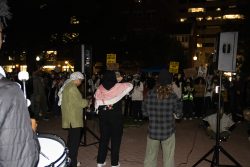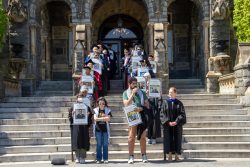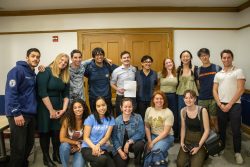Lauinger Library has opened the new Booth Family Center for Special Collections, which will house many of the university’s rare and precious resources on the library buildings fifth floor. The center’s opening represents the final stage of a plan that began in Nov. 2010 to create an improved space for these artifacts and expand the size and scope of the former Special Collections Research Center.
The current exhibition on the Booth Center’s shelves is Treasures Since 2000, which displays some of the most prominent artifacts the library has collected in the past fifteen years. These items range from a letter written by Abraham Lincoln to a copy of the script from an episode of The West Wing filmed at Georgetown.
The collections are divided into four categories: rare books, manuscripts, university archives, and the university art collection. The library gathers these artifacts by gift and by purchase.
“We tailor [these gifts] to match the strengths of the university, so we want to provide materials that support the research and teaching at the university,” said Jennifer Smith, coordinator of communications, outreach, and programming for the library.
As a result, the Special Collections are particularly well-preserved artifacts that reflect theology, literature, Jesuit history, diplomacy, and languages, among other disciplines. Two of the library’s most famous artifacts are Gilbert Stuart’s portrait of John Carroll and Mark Twain’s original handwritten manuscript of The Adventures of Tom Sawyer. Additionally, the Booth Family Center houses the first copy of the Bible printed on the North American continent.
These artifacts can now be displayed in the renovated center as a result of several philanthropic donations to fund the project. The project’s $5 million price tag was paid for largely by a $3 million donation from Suzanne Deal Booth and David G. Booth, a $1 million donation from Barbara Ellis Jones (COL ‘74), and a $500,000 gift from the Lauinger family.
The renovations add 1,200 additional square feet to the former Special Collections facility, making the center 9,200 square feet in total. Part of this increase comes from the creation of a new classroom within the center, enabling professors to bring their classes to engage with the special artifacts and enhance contextual understanding of their area of study.
“This room is specifically designed for the type of instruction that we do,” John Buchtel, Head of the Booth Family Center for Special Collections said. In addition to moveable furniture and built-in display stations, the room will be outfitted with technology focused on research and presentation.
“The thing I’m personally excited about is we will have a ceiling mounted document camera, so I can put a rare book right under the document camera and it will put the image on the screen,” he said. Such technology enables students to zoom onto an artifact and study specific handwriting, for example.
Professors have voiced enthusiasm about the opportunities afforded by the opening of the new center “This will be a great boon to the history department because for all of our classes our learning goals are to get students to develop research skills, and of course historians use primary documents,” Carol A. Benedict, chair of the history department, said. “To be able to do that kind of hands on investigation of primary source materials would be a benefit for our students.”
One motivation for the creation of the new center was the need to ensure that artifacts in the collections are preserved in appropriate environmental conditions.
“The [Lauinger] building is now 45 years old, it was 40 years old when we started talking about this, and the mechanical systems and the [heating, ventilation, and air conditioning] were just not up to increasingly tightened standards for preservation,” University Librarian Artemis Kirk said.
In addition to updating the quality of preservation facilities, the new center also aims to be more accessible to students. Since removing artifacts is not permitted, the center’s expanded reading room and prominent visibility on the floor are intended to attract students to a space that they may have felt restricted from before.
“It’s going to be a lot more welcoming and a lot more accessible,” Benedict said. “I think that in and of itself will probably draw more users and bring people in.”
Photo: Joshua Raftis/Georgetown Voice





